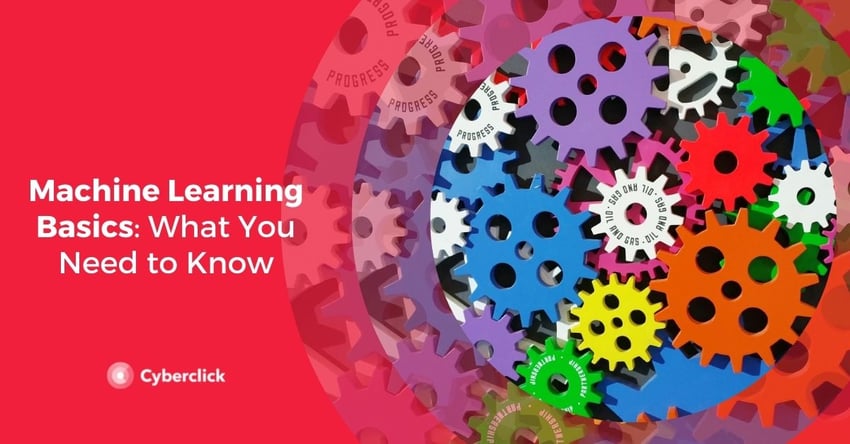You may not realize it, but machine learning is present in our everyday lives, from the voice recognition capabilities of virtual assistants on our phones and other devices to the shows we watch on Netflix or the videos that are recommended to us on YouTube.
Marketing is also making extensive use of this as big data grows and more and more data scientists work on these algorithms. Some of this may sound like Greek to you, but don’t worry—we will guide you through the basics of machine learning.

Definition of Machine Learning
Machine learning is a branch of artificial intelligence (AI) and computer science that allows machines to “learn” from data. Learning in this context means identifying complex patterns in millions of data points, comparing them, and trying to reproduce the way humans acquire knowledge and solve problems. This process is carried out by algorithms that review the data and are able to predict future behaviors. Over time, these algorithms and systems will learn and improve autonomously.
The way a machine learning algorithm works is as follows: after an initial data input, the algorithm classifies the information and produces an estimation about possible patterns in the data. These predictions will be evaluated by the algorithm via an error function that checks the accuracy of the model. To do this, the algorithm will compare different samples and then work on evaluating and optimizing the processes to improve the accuracy of the predictions.
Machine Learning vs. AI
Machine learning and AI have a very strong connection, but they also have different responsibilities. AI aims to create an intelligent computer system to simulate human behavior and solve complex problems, whereas machine learning is really a branch of AI that enables machines to learn from data processing so that they can deliver accurate results. AI is working to create an intelligent system that can perform various complex tasks. Machine learning, on the other hand, seeks to create machines that can perform only those specific tasks for which they are trained.
It's also important to take deep learning and neural networks into consideration here as they are two key aspects in machine learning. Basically, deep learning is a subcategory of neural networks, which are a subcategory of machine learning. Deep learning automates much of the data extraction from the process, whereas neural networks are a series of algorithms modeled after the human brain that aim to imitate human reasoning. In short, neural networks help computers create AI through deep learning.
The capabilities of AI and machine learning are numerous, but let’s focus on some that are linked to our day-to-day life.
- Predicting trends and patterns, recommending products or showing ads according to a person's searches, likes and interactions.
- Speech recognition and language comprehension, like when we ask a device to play music or make a phone call.
- Video and image processing. For example when Facebook automatically identifies the faces in a picture and suggests people to tag.
- Sentiment analysis, which refers to analyzing people’s opinions on products and giving insights to the provider.
3 Types of Machine Learning
We can divide machine learning in three categories: supervised learning, unsupervised learning, and reinforcement learning.
Supervised Learning
This is the most common application for machine learning. Supervised learning algorithms base their learning on previously labeled training data sets. Labeling here means that for each point of a training data set we know the value of its target attribute. This allows the algorithm to "learn" a function capable of predicting the target attribute for a new dataset.
Labeled examples are presented to the algorithm one at a time, and the algorithm must then make a prediction. The human supervisor then checks each prediction made by the algorithm and determines whether it was correct or not. This process is repeated numerous times until the algorithm can predict the relationship between the examples and their labels on its own. Once this is done, the algorithm will be able to work with new examples and predict labels for them.
The simplest example of this is the classification of spam/not spam in emails. First, the machine is given a set of examples of what is junk mail and what is not and how to differentiate them for the user’s sake. Eventually, it will be able to sort the emails in the two folders autonomously.
Unsupervised Learning
Unsupervised learning is the opposite of supervised learning. Here, the algorithms base their training process on a data set without previously defined labels. Unsupervised learning is based on grouping tasks, also called clustering, where the objective is to find similar groups in the dataset. In other words, a set of data and tools is given to the algorithm so that it identifies the information properties on its own and sorts them in a way humans or other machines can understand.
An example is the recommended lists on platforms such as HBO, Amazon or Netflix. When you watch a show or a film, the platform gathers that data and characteristics to find other similar shows and movies that may interest you.
Reinforcement Learning
This method is very different. It uses no labels at all—instead, the algorithm learns by trial and error as it develops. The software learns from its mistakes with each action it performs, thus improving the quality of the method. Reinforcement learning has four essential elements: an agent (the program being trained), an ambient (the ecosystem), an action (a set of actions by the agent) and a reward (the evaluation of the action, positive or negative). Video games use this trial-and-error system a lot and are a great example of reinforcement learning.
We hope this brief introduction to machine learning has been useful in explaining the basics and giving you a clearer picture of this topic. Though it can be complicated, it is also essential nowadays as it plays a big part in the world of marketing. If you don’t believe us, just ask Alexa!
Key Account Manager Engineer en Cyberclick. Experto en desarrollo de aplicaciones web e integraciones entre sistemas con más de 10 años de experiencia. Cuenta con una licenciatura en Matemáticas, Ciclo Formativo de Grado Superior en Desarrollo de Aplicaciones Informáticas y Ciclo Formativo de Grado Superior en Desarrollo de Aplicaciones Multiplataforma.
Key Account Manager Engineer at Cyberclick. Expert in web application development and system integrations with over 10 years of experience. He holds a degree in Mathematics, a Higher Degree in Computer Application Development, and a Higher Degree in Multiplatform Application Development.



.jpg)


Leave your comment and join the conversation